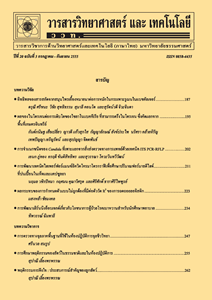การศึกษาชนิดของแบคทีเรียร่วมอาศัยในเพลี้ยจักจั่น Yamatotettix flavovittatus พาหะนำโรคใบขาวอ้อย
Main Article Content
บทคัดย่อ
บทคัดย่อ
งานวิจัยนี้มีวัตถุประสงค์เพื่อศึกษาชนิดของแบคทีเรียร่วมอาศัยในเพลี้ยจักจั่น Yamatotettix flavovittatus (Matsumura) พาหะนำโรคใบขาวอ้อย เพื่อเป็นตัวเลือกในการใช้ควบคุมประชากรของแมลง ผลการศึกษาบริเวณยีน 16S rRNA ของแบคทีเรีย พบแบคทีเรียร่วมอาศัยในเพลี้ยจักจั่น Y. flavovitatus 2 ชนิด คือ Candidatus Sulcia muelleri เป็นแบคทีเรียชนิดปฐมภูมิที่พบในส่วน bacteriome ของแมลงที่อยู่ในอันดับย่อย (suborder) Auchenorrhyncha ส่วนแบคทีเรียอีกชนิดหนึ่งที่พบจัดอยู่ใน class Gammaproteobacteria เป็นแบคทีเรียชนิดใหม่ที่ยังไม่เคยมีรายงานในฐานข้อมูลมาก่อน จึงตั้งชื่อว่า “unknown bacteria in Y. flavovittatus (UBYF)” การตรวจสอบแบคทีเรียร่วมอาศัยทั้ง 2 ชนิด ในประชากรธรรมชาติของเพลี้ยจักจั่น Y. flavovittatus ตรวจพบแบคทีเรีย Ca. Sulcia muelleri และแบคทีเรีย UBYF ประมาณ 80-100 % และตรวจพบจากทุกพื้นที่ที่เก็บตัวอย่าง นอกจากนี้สามารถตรวจพบได้ทุกระยะการเจริญเติบโตตั้งแต่ระยะไข่ ตัวอ่อน และตัวเต็มวัย ผลการศึกษาดังกล่าวคาดว่าแบคทีเรีย UBYF อาจเป็นแบคทีเรียชนิดปฐมภูมิชนิดใหม่ที่อาศัยร่วมกับแบคทีเรีย Ca. Sulcia muelleri ในส่วน bacteriome และมีบทบาทหรือความสัมพันธ์กับเพลี้ยจักจั่น Y. flavovittatus
คำสำคัญ : เพลี้ยจักจั่น; Y. flavovittatus; แบคทีเรียร่วมอาศัยชนิดปฐมภูมิ; โรคใบขาวอ้อย
Article Details
เอกสารอ้างอิง
[2] Aksoy, S., 1995, Wigglesworthia gen. nov. and Wiggleswothia glossinidia sp. nov., taxa consisting of the mycetocyte-associated, primary endosymbionts of tsetse flies, Int. J. Syst. Bacteriol. 45: 848-851.
[3] Wu, D., Daugherty, S.C., Van A.S.E., Pai, G.H., Dunbar, H.E. and Tran, P.L., 2006, Metabolic complementarity and genomics of the dual bacterial symbiosis of sharpshooter, PLoS. Biol. 4: 1079-1086.
[4] Dale, C. and Moran, N.A., 2006, Molecular interactions between bacterial symbionts and their hosts, Cell 126: 453-465.
[5] Montllor, C.B., Maxmen, A. and Purcell, A.H., 2002, Facultative bacterial endosymbionts benefit pea aphids Acyrthosiphon pisum under heat stress, Ecol. Entomol. 27: 189-195.
[6] Russell, J.A. and Moran, N.A., 2006, Costs and benefits of symbiont infection in aphids: Variation among symbionts and across temperatures, Proc. R. Soc. B. 273: 603-610.
[7] Lauzon, C.R., Sjogren, R.E. and Prokopy, R.J., 2000, Enzymatic capabilities of bacteria associated with apple maggot flies: A postulated role in attraction, J. Chem. Ecol. 26: 953-967.
[8] Beard, C.B., Mason, P.W., Aksoy, S., Tesh, R.B. and Richards, F.F., 1992, Transforma-tion of an insect symbiont and expression of a foreign gene in the Chagas disease vector Rhodnius prolixus, Am. J. Trop. Med. Hyg. 46: 195-200.
[9] Hanboonsong, Y., Choosai, C., Panyim, S. and Damak, S., 2002, Transovarial transmission of sugarcane white leaf phytoplasma in the insect vector Matsumuratettix hiroglyphicus (Matsu-mura), Insect. Mol. Biol. 11: 97-103.
[10] วรรณภา ฤทธิสนธิ์, 2547, การตรวจสอบแมลงพาหะนำโรคใบขาวออยและการถ่ายทอดโรคโดยเทคนิคทางชีวโมเลกุล, วิทยานิพนธ์ปริญญาโท, มหาวิทยาลัยขอนแกน, ขอนแก่น.
[11] Wangkeeree, J., Miller, T.A. and Hanboon-song, Y., 2012, Candidates for symbiotic control of sugarcane white leaf disease, Appl. Environ. Microbiol. 78: 6804-6811.
[12] Moran, N.A., Tran, P. and Gerardo, N.M., 2005, Symbiosis and insect diversification: An ancient symbiont of sap-feeding insects from the bacterial phylum bacteroidetes, Appl. Environ. Microbiol. 71: 8802-8810.
[13] McCutcheon, J.P. and Moran, N.A., 2010, Functional convergence in reduced genomes of bacterial symbionts spanning 200 my of evolution, Genome Biol. Evol. 2: 708-718.
[14] Noda, H., Watanabe, K., Kawai, S., Yukuhiro, F., Miyoshi, T. and Tomizawa, M., 2012, Bacteriome-associated endo-symbionts of the green rice leafhopper Nephotettix cincticeps (Hemiptera: Cicadellidae), Appl. Entomol. Zool. 47: 217-225.
[15] McCutcheon, J.P., McDonald, B.R. and Moran, N.A., 2009, Origin of an alternative genetic code in the extremely small and GC-rich genome of a bacterial symbiont, PLoS Genet. 5: 1-11.
[16] Gonella, E., Negri, I., Marzorati, M., Sacchi, M.L., Pajoro, M. and Daffonchio, D., 2011, Bacterial endosymbiont localization in Hyalesthes obsoletus, the insect vector of bois noir in Vitis vinifera, Appl. Environ. Microbiol. 77: 1423-1435.
[17] Baumann, P., 2005, Biology of bacteriocyte-associated endosymbionts of plant sap-sucking insect, Annu. Rev. Microbiol. 59: 155-189.


